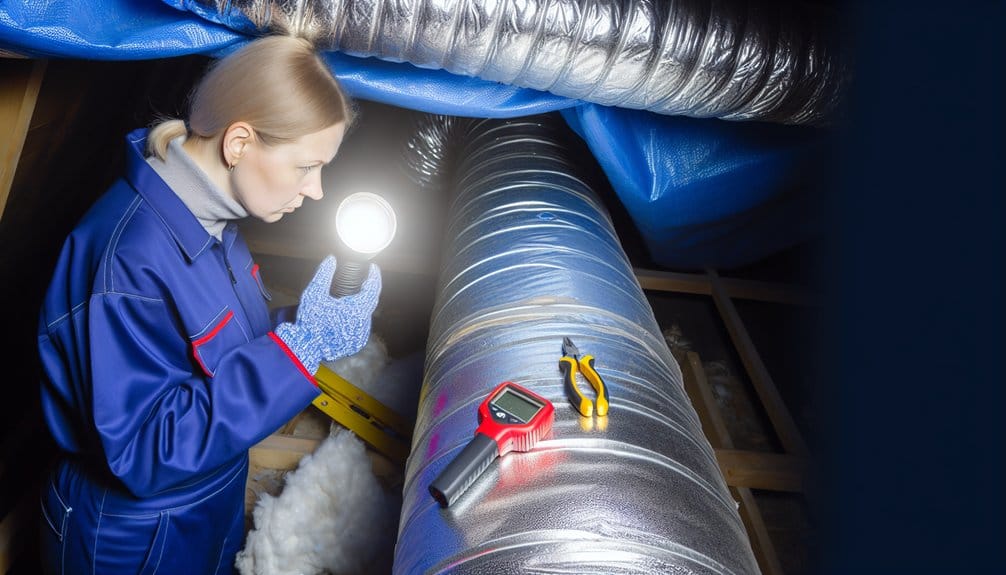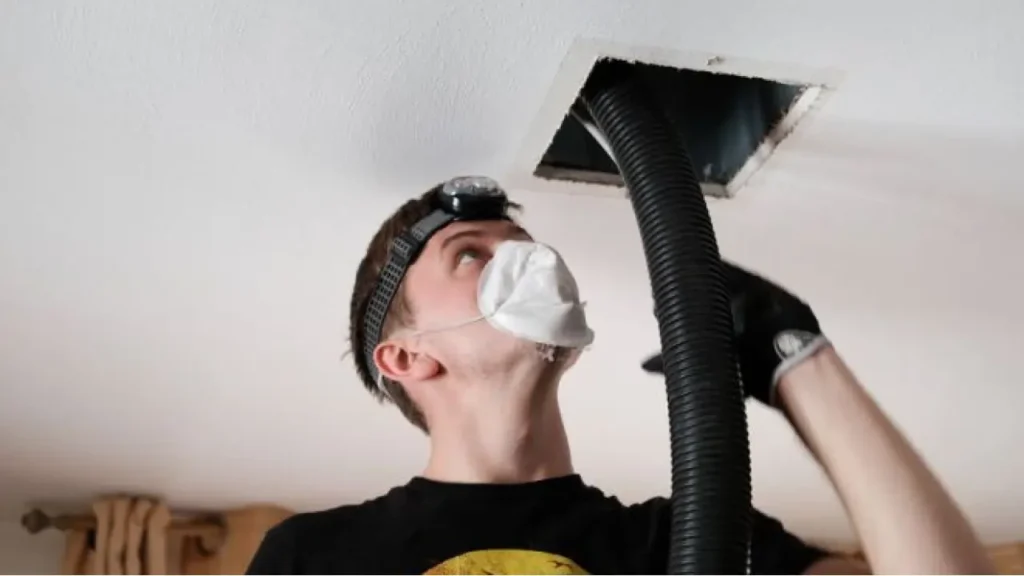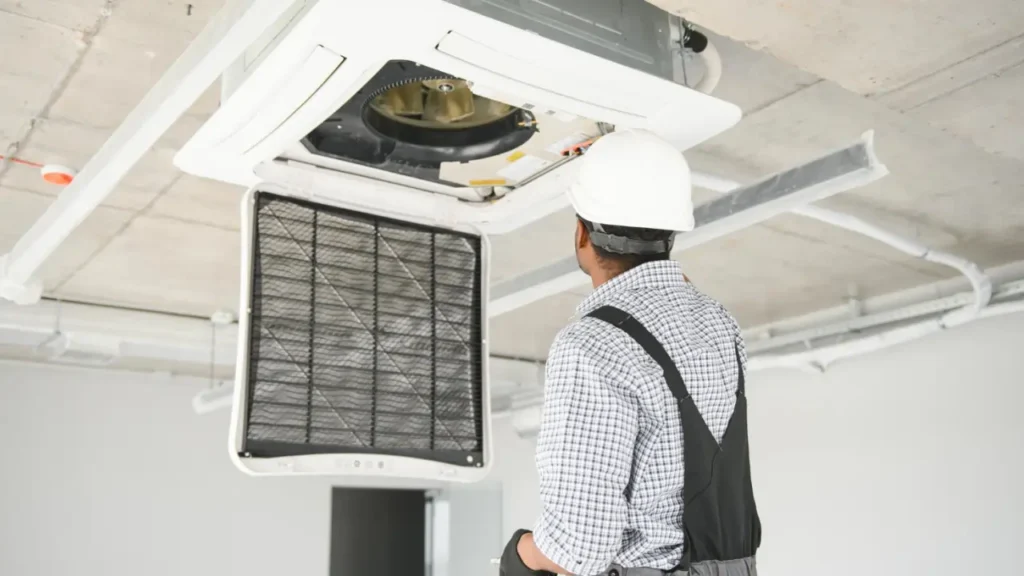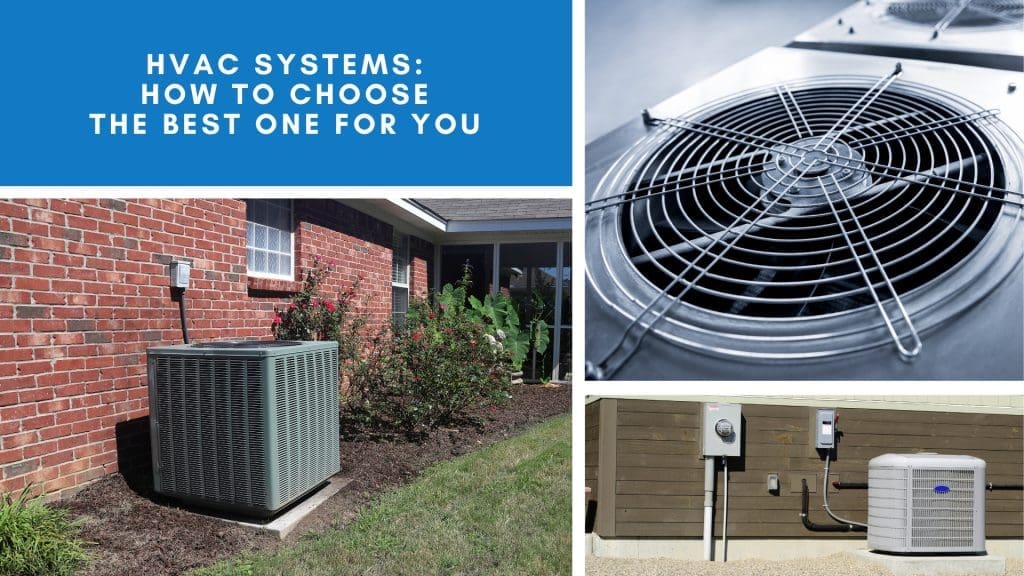Your HVAC system is the heart of your home’s comfort. It keeps you cool in the summer and warm in the winter. But did you know that the ductwork, the system’s arteries, plays a crucial role too?
Ducts carry conditioned air throughout your home. If they’re not in good shape, your comfort, air quality, and wallet could suffer. That’s where Duct Inspection Techniques come in.
Duct inspection is a vital part of HVAC maintenance. It helps identify issues like leaks, blockages, and buildup of contaminants. These problems can affect your system’s efficiency and your home’s air quality.

In this guide, we’ll delve into the world of duct inspection. We’ll explore why it’s essential, when it’s needed, and what it involves. We’ll also discuss how to find professional services and maintain your ductwork.
Whether you’re a small business owner, a work-from-home professional, or a busy stay-at-home mom, this guide is for you. Let’s ensure your HVAC system is working at its best, so you can focus on what matters most.
Why Duct Inspection is Crucial for Your Home and Business
Regular duct inspection is vital for ensuring a safe and comfortable environment. It helps maintain optimal air quality, crucial for both home and workplace settings. Clean ducts mean less dust, allergens, and contaminants circulating indoors.
One significant advantage of consistent duct inspection is energy efficiency. When ducts are free from leaks and blockages, your HVAC system doesn’t have to work as hard. This boosts its efficiency and can even lower energy bills.
Proper duct inspection also contributes to the longevity of your HVAC system. By identifying and addressing issues early, you can prevent costly repairs or replacements. This proactive approach ensures your system continues running smoothly for years to come.
Duct inspections can uncover hidden problems:
- Leaks and gaps leading to energy loss
- Blockages from dust or debris
- Mold or pest infestations affecting air quality
Moreover, it is a preventative measure that prioritizes health. Poor indoor air quality can exacerbate allergies or respiratory issues. For small business owners, ensuring a comfortable workplace boosts employee satisfaction and productivity.
In short, duct inspection is about safeguarding comfort and well-being. It is an essential part of any maintenance routine, whether at home or in business.
Recognizing the Signs: When to Schedule a Duct Inspection
Knowing when to schedule a duct inspection is crucial. Certain signs indicate that it’s time to take action. Recognizing these can save you both money and hassle in the long run.
First, if you notice uneven temperatures throughout your home or business, this may be a sign. It could mean your ducts have blockages or leaks. You’ll want a professional to investigate to maintain comfort.
Another indication is a sudden increase in dust accumulation. If you’re noticing more dust on surfaces than usual, this might signal dirty or clogged ducts. Proper cleaning may be necessary to restore air quality.
Strange odors coming from vents are a red flag. They could be indicative of mold, pests, or other contaminants lurking in your ductwork. Don’t ignore such signs; schedule an inspection promptly.
Consider these common signs as prompts:
- Rising energy bills without a clear cause
- Frequent cold spots or drafts
- Unexplained respiratory issues or allergies
- Audible noise or rattling from ducts
If any of these signs are present, an HVAC inspection could be beneficial. Proactive duct inspections can uncover issues before they escalate. This not only improves air quality but also enhances system performance, providing peace of mind.
The Duct Inspection Process: What to Expect
Duct inspection might seem technical, but knowing what to expect can ease concerns. Generally, an HVAC professional starts with a thorough assessment. They’ll look for visible signs of damage or wear in your ductwork.
During the process, they check for leaks and blockages. These can hinder airflow and efficiency. An inspection helps identify these issues early. Technicians use specialized tools to examine the ducts. This ensures a detailed and accurate review of the system.
They also assess the cleanliness of the ducts. If contaminants are present, duct cleaning may be recommended. Keeping your ducts free from dirt and debris enhances air quality.
Finally, the inspection results lead to actionable recommendations. You’ll receive a report detailing findings and suggested next steps. This way, you know exactly what’s needed to keep your HVAC system in top shape.

Visual Inspections vs. Camera-Assisted Inspections
When it comes to inspecting your ducts, there are two main approaches: visual and camera-assisted inspections. Visual inspections are traditional. A technician visually examines easily accessible areas of the ductwork.
Visual inspections, though helpful, might miss hidden issues. That’s where camera-assisted inspections come in. These use specialized cameras to explore ductwork thoroughly, even in hard-to-reach spots.
Camera-assisted inspections provide a clearer picture. Technicians can identify problems not visible during a standard inspection. This detailed view helps in accurately diagnosing and resolving issues.
Choosing the right inspection approach depends on your specific needs. While visual inspections are beneficial, camera-assisted ones offer a more comprehensive evaluation. They ensure even the smallest issues are discovered and addressed.
Advantages of Air Duct Camera Inspections
Camera inspections offer several benefits over traditional methods. First, they provide a detailed view of the inside of your ducts. This allows for precise identification of issues.
One major advantage is accuracy. Air duct inspection cameras reveal fine details that human eyes might miss. This results in more effective diagnosis and treatment of duct-related problems.
Another benefit is efficiency. These inspections can often be completed faster. With a camera, technicians quickly assess and decide on the necessary actions, saving you time.
Lastly, air duct camera inspections give homeowners peace of mind. You know issues are being handled with precision. The thorough nature of this approach means cleaner, healthier air in your living spaces.
Choosing the Right Professional for Your Duct Inspection
Selecting a reliable professional is crucial for a successful duct inspection. First, prioritize certifications and experience in the HVAC field. A well-qualified technician knows how to conduct thorough inspections.
Check for customer reviews and testimonials. These provide insight into past performance and customer satisfaction. Ask for recommendations from friends or family who have used similar services.
Request a detailed explanation of their inspection process. Understanding their approach helps ensure it aligns with your needs. Discuss any potential additional services, like duct cleaning or repair.

Consider these key factors:
- Certification and training: Are they licensed?
- Experience: Have they handled similar projects?
- Customer feedback: What do past clients say?
- Transparency: Are they upfront about their process?
- Pricing: Is the cost reasonable and clear?
By taking these steps, you’ll find a professional you can trust. Quality service ensures your HVAC system remains efficient and effective.
Duct Maintenance: Tips for Keeping Your Ducts in Top Shape
Regular maintenance is key to keeping your ducts healthy. It can improve efficiency and longevity. Proper care can prevent costly repairs.
Start by scheduling routine inspections with a professional. They can identify potential issues before they become major problems. This proactive approach saves time and money in the long run.
In addition to professional help, homeowners can take simple steps. Keep your vents and registers free of dust and debris. Change your HVAC filters regularly to ensure clean airflow.
Here are some practical tips for ongoing duct maintenance:
- Regular inspections: Schedule a check every few years.
- Keep vents clean: Dust them every couple of months.
- Replace filters: Do this every 1-3 months.
- Seal leaks: Promptly address any visible gaps.
- Monitor airflow: Ensure it remains consistent.
By implementing these measures, you enhance your home’s air quality. Consistent duct maintenance contributes to a comfortable, safe environment. Your HVAC system will run efficiently, benefiting your whole household.
The Impact of Duct Inspection on Air Quality and Health
Duct inspections play a vital role in maintaining a healthy indoor environment. Clean ducts ensure that the air circulating throughout your home is free from dust, allergens, and pollutants. This is especially important for individuals with asthma or allergies.
Regular inspections help identify and remove contaminants that may be lurking within your ductwork. Mold, dust mites, and even pests can negatively impact air quality, leading to health concerns. Addressing these issues can significantly enhance the air you breathe.
Moreover, well-maintained ducts improve overall system efficiency. This reduces the strain on your HVAC system, thus conserving energy and lowering utility bills. An efficient system provides consistent airflow, ensuring that your home remains comfortable.
By investing in regular duct inspections, you’re not just boosting your HVAC system’s performance. You’re also taking steps to protect your family’s health. Prioritizing duct cleanliness results in a healthier, happier living space for everyone in your home.
Understanding the Results: Interpreting Your Duct Inspection Report
After a duct inspection, you’ll receive a detailed report. This document will highlight areas needing attention, such as leaks or blockages. Understanding this report is key to making informed decisions about maintenance.
The report will often start with general observations. It may include the condition of your ducts and any potential issues found. Pay attention to any recommendations provided, as they will guide you in addressing problems.
Look for specific details about contaminants like dust or mold. These findings indicate the level of cleaning needed to improve air quality in your home. Knowing the severity of these issues helps prioritize necessary actions.
Finally, consider the expert advice offered by your HVAC professional. They can explain the report in simple terms and suggest the best course of action. Understanding your duct inspection report empowers you to take the right steps toward maintaining a healthy and efficient home.
Conclusion: The Long-Term Benefits of Regular Duct Inspections
Regular duct inspections bring lasting benefits to your home and business. They ensure your HVAC system runs efficiently, potentially lowering your energy bills. This cost-saving aspect can be substantial over time.
Beyond cost savings, duct inspections contribute to a healthier living environment. They help identify and address issues like mold growth or pest infestations, improving air quality significantly. Clean air ducts mean fewer allergens and healthier breathing.

Lastly, regular inspections can extend the life of your HVAC system. By catching small issues before they escalate, you’ll avoid costly repairs down the line. Investing in regular duct inspections pays off with peace of mind and enhanced home comfort.


